MSI’s GeForce N470GTX & GTX 470 SLI
by Ryan Smith on July 30, 2010 1:28 PM ESTGTX 470 SLI: Power, Temperature, & Noise
Wrapping up our look at the GTX 470 SLI, we’ll take a look at power, temperature, and noise. We have already well-established that GF100 cards can be particularly power hungry compared to their Radeon competition at similar performance levels, so this will give us a chance to see just what the situation is like when we throw multi-GPU in to the mix.
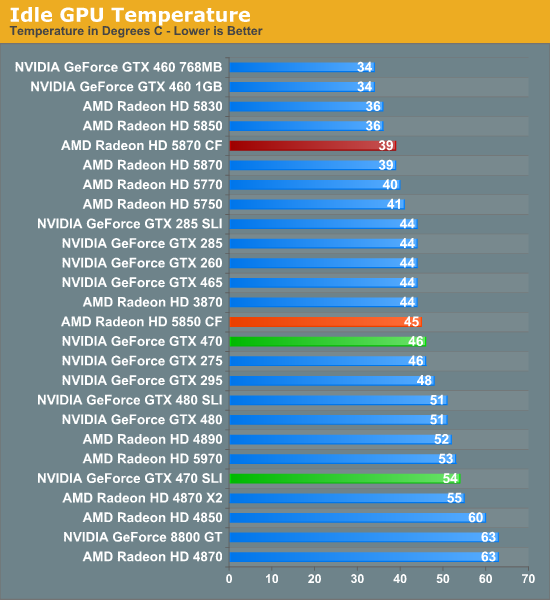
Having 2 video cards usually has a negative effect on idle conditions, and the GTX 470 SLI is no different here. Having a second card blocking the first pushes the temperatures of the first card up by 8C.
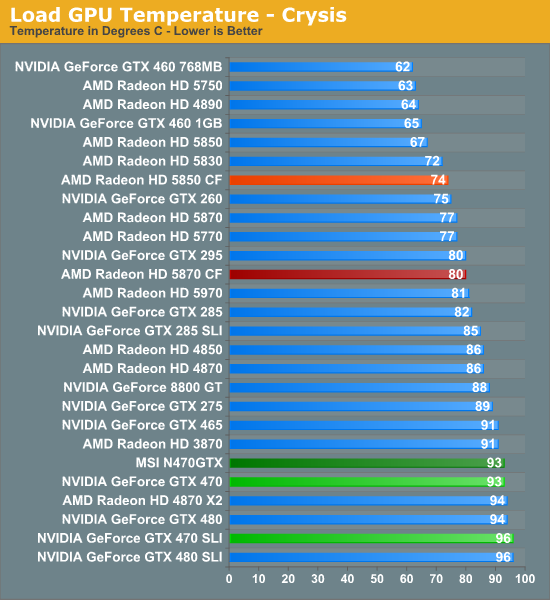

Load temperatures are similarly affected. The GTX 470 SLI ends up performing just like the GTX 480 SLI here, peaking at 96C under Crysis and stabilizing at 96C under Furmark. NVIDIA strongly suggests separating GTX 400 cards when in SLI for this exact reason – these results are when we already have a fan behind the cards. The Radeon cards do end up in a similar situation, but ultimately they still stay below 90C when in CF mode.
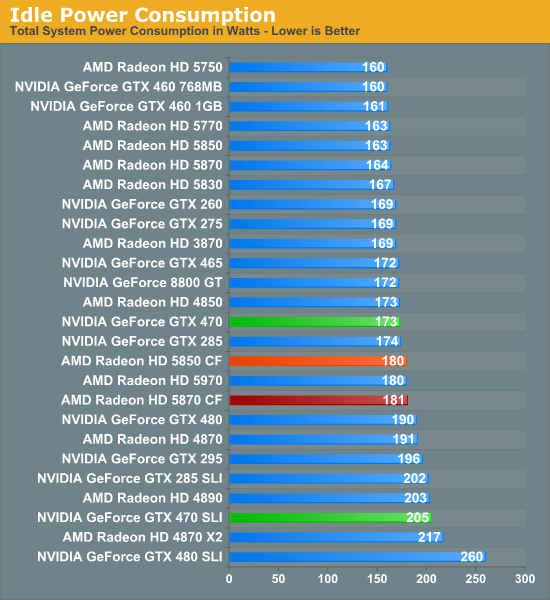
Compared to the GTX 480, the GTX 470 has noticeably lower idle power consumption, which cascades in to our SLI results. The 470 GTX SLI ends up consuming 55W less than the GTX 480 while idling, while consuming around 25W more than the Radeon cards in CF mode.
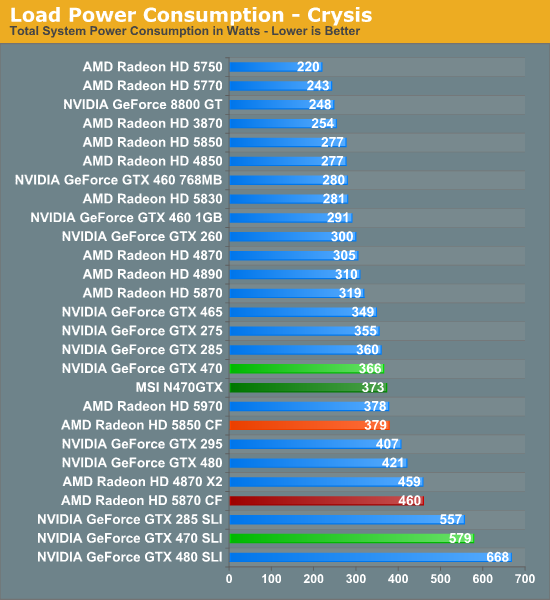
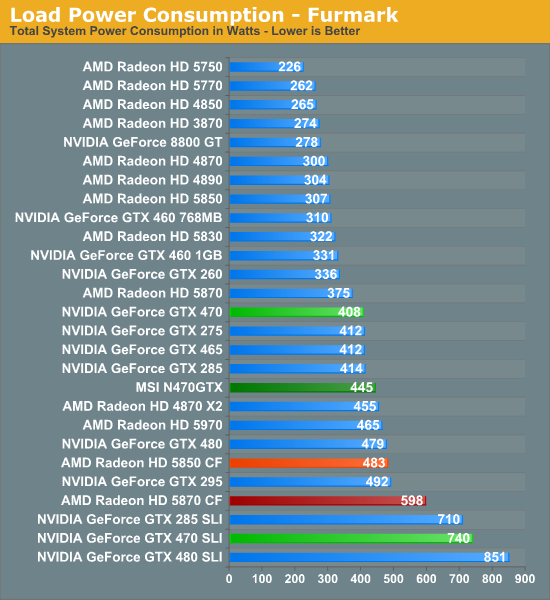
When the GTX 480 SLI became the most power hungry dual-GPU setup we’ve ever tested, there was little reason to believe that the GTX 470 SLI wouldn’t follow it, so these results shouldn’t be surprising. With Crysis the GTX 470 SLI pulls nearly 100W less than the GTX 480 SLI, but it still pulls between 100W-200W more than the Radeon cards in CF. Furmark is a similar story, but here the difference between the GTX 470 SLI and the Radeon cards is now 150W-250W.
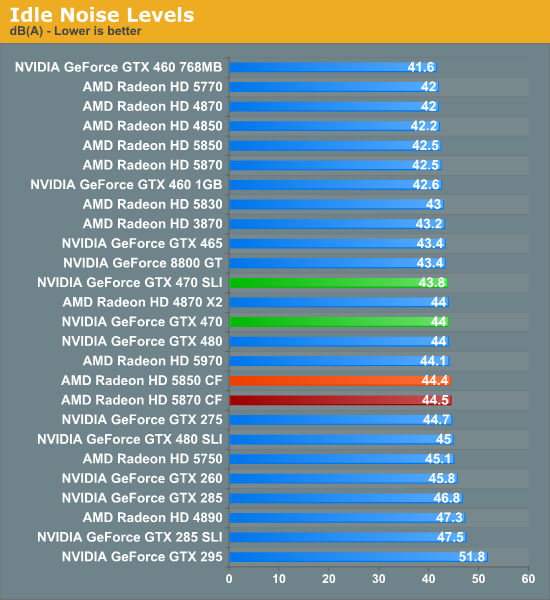
Idle noise is more or less a solved problem. The vast majority of modern coolers emit almost no noise when idling, resulting in SLI having little impact on idle noise.
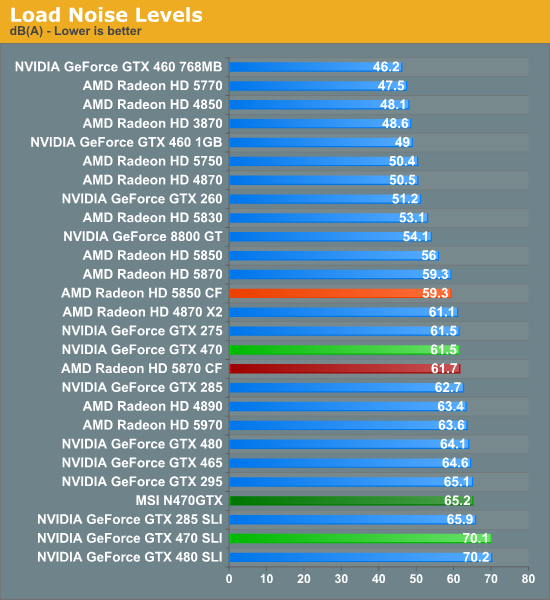
Our noise charts usually closely follow our power charts, so these results should not be surprising. With the partially obstructed GTX 470 card exceeding 90% of its top fan speed, the SLI combination is second only to the GTX 480 SLI. This is 8dB-11dB louder than the Radeon cards, and makes the GTX 470 SLI the clear winner/loser for the second-worst spot on our load noise charts.
Overall these results closely mimic what we saw with the GTX 480 SLI back when it launched: 1 GF100 card is hot & loud, and 2 cards are even hotter and louder. As the saying goes: cheap, quiet, high-performance – pick any 2.










41 Comments
View All Comments
tech6 - Friday, July 30, 2010 - link
Is it just me getting old or have desktop PC become somewhat boring? There seems to be a lot more sizzle and innovation in mobile, server and even home theater tech.lunarx3dfx - Friday, July 30, 2010 - link
I have to agree, I really miss the days of Overclocking with dip switches and jumpers, and when a 100 MHz OC actually meant performance you could feel and see. It's not as much fun as it used to be. The mobile market, smartphones especially, has gotten very interesting in recent years especially if you have gotten into homebrew and seeing what these devices are really capable of.araczynski - Saturday, July 31, 2010 - link
i wouldn't say boring, just that each new iteration of cards is becoming less and less important.game developers aren't pushing hardware as hard as fast as the manufacturers would want them to.
i've had my 4850's in CF since they came out, and i'm still playing everything at 1080p to this day, granted, i don't use AA, but i never have, so don't care.
dragon age, mass effect 2, star craft 2 all smooth as butter, why am i going to waste time/money with a new video solution?
this is still on my E8600(?) 3.16Ghz C2D. (win7).
people are buying too much into the marketing, so cudos to their marketing departments, or which anandtech is one i suppose.
7Enigma - Monday, August 2, 2010 - link
Hmm...have you checked to see if you are CPU limited in games? I have the same CPU and would guess that at 1080p resolution you could very well be CPU limited at stock E8600 speeds. I have the same proc and it is easy as pie to OC to close to 4GHz. I currently run at 3.65GHz at stock voltage and game at 3.85GHz (again stock voltage) with little more tweaking than upping the frequency (9.5X multi, 385MHz bus). And that's just with an OC'd 4870, dual 5850's surely could use the extra cpu power at such a (relatively) low resolution.HTH
quibbs - Monday, August 2, 2010 - link
In my humble opinion, games drove the PC market into mainstream. It spurred the development of most of the major components. This includes graphics cards. Especially graphic cards. But it seems that game development for the PC, while still major, isn't what it once was. This has to slow down the video card market as the games for PC are less numerous.Perhaps a major breakthrough in gaming (3d, holograms,etc) will continue the card wars, but I think it will eventually head in a different direction. A reversal if you will, energy efficient cards in smaller form factor that are very potent at pushing graphics. Think about it, the cards are getting bigger and more power hungry as they grow in capabilities. At some point this will be unsustainable (in many ways).
Some company will realize that less is more and will produce such a product (when technology permits), and will kick off the new wars.
Just a thought....
piroroadkill - Monday, August 2, 2010 - link
We're getting more and more powerful hardware, but most games are being developed with consoles in mind, so the benefit of having a vastly more powerful machine is very small.I don't feel like I need to upgrade my 4890 and C2D @ 3.4 for gaming, at all. To be honest, my 2900XT didn't really need upgrading, but it ran really hot and started to balls up
softdrinkviking - Monday, August 2, 2010 - link
i don't know what a 2900xt is, but i upgraded from a radeon 3870 because i couldn't play butcher bay or a couple of other titles at my screens native 1920x1200. that was without AA or MSAA or any kind of ambient occlusion or anything, it just couldn't hold the framerates at all.so i got a 5850, and it's been great for everything under the sun. sometimes i can even max out the AA and stuff and the games play fine. (not in crysis)
anyway, the current gen of consoles games can usually take advantage of a regular LCDTV's 1080p, so if i can't play a game at that resolution without any extra visual enhancements selected, that sounds like there is room for improvement.
As for the future of gaming, i personally believe that computers will supplant consoles eventually.
maybe as soon as 15 years?
it's just a guess, i can't back it up, but i personally can't see how sony will be able to afford losing so much money on a new generation console.
if the current generation lasts long enough for sony to take advantage of the, only recently profitable, PS3, then home PCs will have a chance to get much faster and cheaper before a PS4 has time to come to fruition.
it just seems like the consoles will eventually become financially untennable.
damn, my dog just died, gotta go.
afkrotch - Monday, August 2, 2010 - link
All depends on hardware and games. I have to turn down my game settings on Metro 2033. I use a C2D @ 3.3 ghz and a GTS 250. I get way too much framerate drops at 1920x1200 no AA/AF.Granted, I can still play any game out there, so long as I'm willing to lower the quality/resolutions.
arnavvdesai - Friday, July 30, 2010 - link
I just wanted to ask if the author or the staff on AT feel that desktop graphics card are a shrinking market? Is the continued investment by ATi and Nvidia into the development of newer cards seem justified? I own a 5870 and barring a technical fault I dont plan to upgrade for another 3 years as I dont see myself upgrading my monitors.Is the market slowly but surely reducing or am I just wrong in assuming that? If yes, then where should these companies research into?
nafhan - Friday, July 30, 2010 - link
Well, the tech that goes into making a high end card eventually makes it into mobile, low end, integrated, cell phone, and console parts through a combination of cutting down the high end and successive silicon process improvements. So, ATI and Nvidia don't expect to make all their R&D money back from the initial run of high end GPU's. High end GPU's are basically proof of concepts for new technology. They'd certainly like to sell a bunch of them, but mostly they want to make sure the technology works.